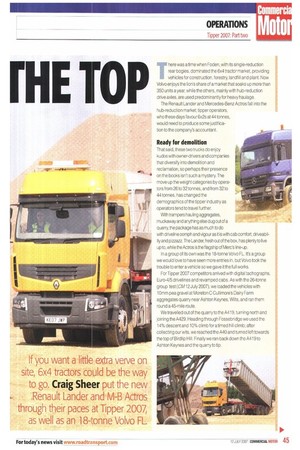TIPPED FON THE TOP
Page 44

Page 45

If you've noticed an error in this article please click here to report it so we can fix it.
here was a time when Foden, with its single-reduction rear bogies, dominated the 6x4 tractor market, providing vehicles for construction, forestry, landfill and plant. Now Volvo enjoys the lion's share of a market that soaks up more than 350 units a year, while the others, mainly with hub-reduction drive axles, are used predominantly for heavy haulage.
The Renault Lander and Mercedes-Benz Actros fall into the hub-reduction market; tipper operators, who these days favour 6x2s at 44 tonnes, would need to produce some justification to the company's accountant.
Ready for demolition
That said, these two trucks do enjoy kudos with owner-dryers and companies that diversify into demohtion and reclamation, so perhaps their presence on the books isn't such a mystery. The move up the weight categories by operators from 26 to 32 tonnes, and from 32 to 44 tonnes, has changed the demographics of the tipper industry as operators tend to travel further.
With trampers hauling aggregates, muckaway and anything else dug out of a quarry, the package has as much to do with driveline oomph and vigour as it is with cab comfort, driveability and pizza77. The Lander, fresh out of the box, has plenty to live up to, while the Actros is theflagship of Merc's line-up.
In a group of its own was the 18-tonne Volvo FL. It's a group we would love to have seen more entries in, but Volvo took the trouble to enter a vehicle so we gave it the full works.
For Tipper 2007 competitors arrived with digital tachographs, Euro-4/5 drivelines and revamped cabs. As with the 26-tonne group test (CM12 July 2007), we loaded the vehicles with 10mm pea gravel at Moreton C Cullimore's Dairy Farm aggregates quarry rear Ashton Keynes, Wilts, and ran them round a 45-mile route.
We travelled out of the quarry to the A419, turning north and joining the A429. Heading through Fossebridge we used the 14% descent and 10% climb for a timed hill climb; after collecting our wits, we reached the A40 and turned left towards the top of Birdlip Hill, Finally we ran back down the A419 to Ashton Keynes and the quarry to tip.


























































































































































































